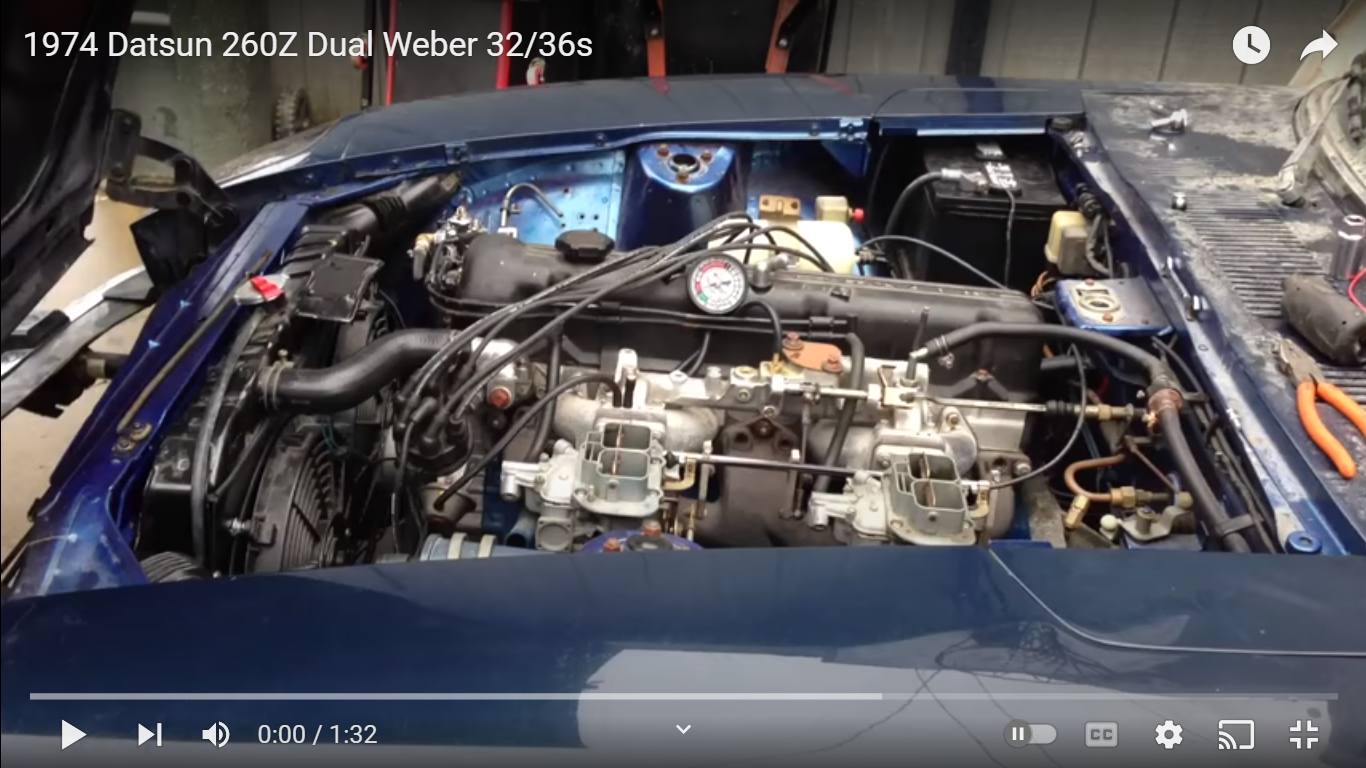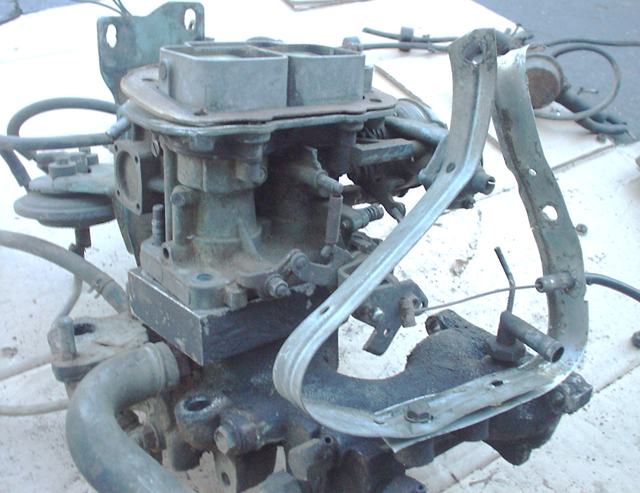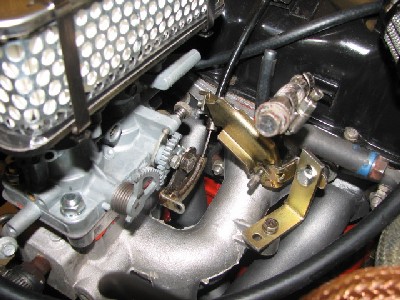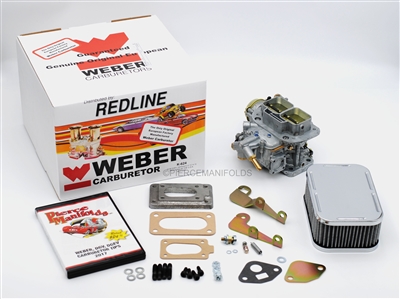The Weber DGV series is a two-barrel progressive linkage downdraft carburetor. It runs on the smaller venturi for better economy and throttle response until the throttle is pushed down to about half way, at which point the larger throttle starts to open. At full throttle both side are wide open. Italian design. High fuel-economy. Excellent top-end power. Tunable. Available. Easy to work on. Did I mention inexpensive?
Overview
The Weber <DGV> series is a 2-barrel carburetor from the Italian company of Weber. With all their racing and OEM experience, you know they know how to design carburetors. The 32/36 features progressive throttle design for good economy (with first bore open) and great power (when both bores open). Being a down-draft carburetor it is easily adapatable to many stock engines, including Nissan A engines. And new Webers are available to replace a worn-out 50 year old carburetor.
POST Did you notice a performance increase?
Features:
- designed for engines displacing 1200cc-2300cc
- versatility, can be applied to street or racing
- wide adaptability to all kinds of engines
- easy installation, a simple adapter and linkage only is needed.
- An installation kit designed for the A-engine can be purchased from a Weber distributor
- low initial cost, either brand-new or used
- trouble-free maintenance
- excellent drivability due to many circuits (idle, off idle, power valve, etc)
- increased fuel economy
- improved performance
The DGV Series carbs feature models with manual, water or electric choke actuation. The DGV also has a power valve circuit to facilitate low vacuum (full throttle) conditions.
DGxV series name was generated from the Italian:
- Doppio - twin
- G - Right-hand oriented
- V - Verticalle (verticle) or V (power valve-equipped)
x can be either: 1) none - manual choke 2) E - electric choke or 3) A - Aqua (water) choke
There is also a corresponding DFV-series, which are nearly identical except they are a mirror-image of the DGV (for left-hand orientation). In the DFV, the primary and secondary barrel position reversed in the body. The throttle lever in the DFV rotates in a clockwise motion while the DGV rotates anti-clockwise. The other difference is in the air cleaner flange.
Right-hand (DGV) vs. Left-hand (DFV)


Measurements
Measurements Bores: 32/36 (Primary bore/Secondary bore) Venturis: different sizes Bore spacing: 43mm Stud spacing: 47mm x 93mm
Choosing between 32/36 and 38/38
For even more performance at a slight penalty in fuel economy see, the Weber DGAS carburetor synchronous opening model (both throttles open simultaneously). This is a high performance alternative to most any DGV applications.
Notice that both throttle are geared to open together

quote: The 32/36 DGV progressive carburetor as used in any Redline Weber kit is pre-calibrated and set to run on most normal standard and stock engines and provide a performance and fuel economy improvement. If that engine has been upgraded or improved with other performance items there will be a need to recalibrate or rejet the carburetor in some situations. There is a performance jet kit just for the Jeep applications Pt No. 701-DGV.
The 38 DGAS synchronous carburetor when supplied in kit form from Redline Weber is also pre-calibrated for use on stock or slightly modified motors and will not be over carbureted. It also provides the best starting point for engines that are ultimately going to be upgraded with additional performance Items with performance over fuel economy being the ultimate goal.
For more details on choosing between DGV and DGAS series, see redlineweber.com: Making the right choice☁
Weber DGV Models
| DGV | manual choke |
| DGEV | automatic (electric) choke |
| DGAV | automatic (water heated) choke |
| DFEV/DFAV | mirror-image to DGV series |
| Holley 180 | Australian licensed version of Weber 32/36 |
| Holley 5200 | US licensed version of Weber 32/36 |
They are available in different venturiᵂ sizes:
- 235 CFM: 23/27 - 23mm primary venturi (1979-82 Fords)
- 270 CFM: 26/27 - 26mm primary venturi
- 330 CFM: 23/29 - 1979-up Chevrolet Chevetteᵂ
Curent Weber Part Numbers:
22680-033B DGEV electric choke (E = electric) 22680-051 DGAV water choke (A = aqua) 22680-056 DFEV 22680-070 DFAV
Holley G180/Holley 5200 Series
In 1970 the Holley carburetor companyᵂ licensed the DGV design from Weber. Inside the carb it actually says "Weber", but outside there is a different brand name. Holley's first version was the Holley 5200, fitted to the 2-liter German Ford OHC ("Cologne") engine in the 1971 Ford Pintoᵂ.
5200 was used on: * All Ford 2.3 liter carbureted engines * USA models with 2.8 V6 carbureted engines * Ford Pinto/Mercury Bobcat 2.0 and 2.3 * Mercury Capriᵂ German-made Capri circa 1974 * Mustang IIᵂ (1974-1978) * Fox-body Fordsᵂ (1978-1986): ** Mustang/Capri, Fairmont/Zephyr, LTD/Marquis, Granada, Thunderbird * 1979-1982 Ford Courierᵂ Pickup 2-liter engine (Isuzu truck)
The Holley 5210 variation was designed for the Chevrolet Vegaᵂ 2.3 liter engine and first used in 1973. The main difference is a built-in GM-style fuel filter in the top casting.
5210 was used on * 1973-1977 Chevrolet Vega * 1977 Pontiac Astre * Pontiac "Iron Dukeᵂ" * Chevette * 2-liter Audi engine (Porsche 924 engine) in the AMC Gremlinᵂ
5220 variation of 5210 was used on: * Dodge Omniᵂ and its twin Plymouth Horizonᵂ 1.7 liter Volkswagen engine and the Chrysler 1.7, 1.6 & 2.2 engines
Chevette Carburetor on A14 (B310):

In Australia, the G180 is a licensed version of the Weber 32/36 and fitted to: * 2-liter Ford Escortᵂ * 2-liter Ford Cortinaᵂ
All these Holley models are nearly identical. There are small differences between each model and between the Webers.
NOTE: Some Holley 5200/G180 carbs have only a primary idle system, while others have both primary and secondary idle system.
Go to the library and get this book: "Holley Carburetor Systems 5200 Series" by Mike Urich, HPBooksᴳ. Or just $8 from Amazon.com (2008 price)☁
Airflow, CFM
5200 series carbs are mostly fitted with 26mm primary and 27 mm secondary venturis, giving 270 CFM @ 3 inches mercury (note that this is equivalent to a 4-barrel type rating of 193 CFM — 4-barrel carbs are rated at 1.5 inch mercury).
* 270 CFM: 26/27 venturis (193 CFM equivalent to 4-bbl style rating) * 235 CFM: 23/27 (some, starting in 1978) * 245 CFM: 23/29 (1979 up Chevette)
The 245 CFM model sounds like a good candidate for a 1200cc engine as compared to the stock Hitachi carb's 20/26 venturis.
Identification
Holley carbs can be identified by a metal tag attached to a top screw, or by a stamping on the side of the carb base plate.
* 1st number: Engineering/List number, as noted in some parts listings * 2nd number (if present): List revision * Last number: Date. First three digits are day of year ** (0=Jan 1, 356 =Dec 31), last digit is the year (0=1970, 9=1979)
Variations
Some 52xx carbs have:
External Fuel bowl vent. Most have internal venting. Some have emission style venting which is connected to a charcoal canister (you can connect it to the air cleaner — inside the filter portion)
External Fuel bowl vent with solenoid control. As above, but you need to wire the solenoid to 12V. Failure to do so will cause running problems
Idle-cutoff solenoid (Anti-dieseling solenoid), identified by a wiring connector. You need to wire the solenoid to 12V. Failure to do so will cause failure to idle. The carb will run good except it won't idle. See Anti-diesel valve
Fuel return fitting. A/C cars sometimes have this. Datsun 1200s do not have a fuel return line. Block this line.
Secondary idle system. Most 5200s only have a primary idle.
Screw-in vs Press-in idle circuit restrictors (don't worry about these, they are not normal tuning items). Some newer ones have a restriction in the circuit well (installed from carb top rather than on the side)
Mixture screw restrictor cap (idle limiter). Remove this unless local laws require them
Idle transfer circuit: holes vs narrow slot vs wide slot. The slots apparently are better, but you can't modify this so don't worry about it.
Double-venturi is used on some newer versions for better driveability and fuel economy. This is preferred unless you have a drag racer in which case the single-venturi is better (at about 7% better airflow).
Choke Types:
- Water-heated
- Water-heated with electric assist
- Electric
Deceleration valve fitting. Some models have this just under the air cleaner flanged by the choke. Plug this fitting.
Holley 6500
The Holley 6200/6500 is a feedback version of the 5200 carburetor, an electronically controlled jet system. Early models used a vacuum switch while newer models used an Oxygen sensorᵂ (Lambda sensor).
Holley previously sold an electronic "dial a jet" package that would plug into the 6500, bypassing the oxygen sensor and letting you control the amount of fuel through a dial on the dashboard. This was the "Holley Electronic Carburetor" system with a 11-position controller module, that varied mixture about 12 jet sizes just by turning the dial. A "computer" was optional and monitored fuel economy and other factors. reference: Aaronᴬᴿᶜᴴᴵⱽᴱ
The 6500 used a modified power valve assembly. Instead of a simple open/closed valve, this is a metred valve. It is controlled by a needle raised/lowered by a solenoid on the carb.
Components needed are:
- Carb
- Lambda (Oxygen) sensor (for 6510/6520 models)
- Control box
- Solenoid and Vacuum Control Valve
- Wiring
The 6500 Vacuum Feedback model (no O2-sensor) was used on:
- 1978-1980 Ford 2.3 liter California market
- 1981-up Ford 2.3 liter USA Federal + California markets
The 65xx Electronic Feedback model (with O2-sensor) was used on:
- 6510: 1980 Chevette, California market
- 6510: 1981 Chevette, Federal + California markets
- 6520: 1980 Dodge Omni/Plymouth Horizon, California market
- 6520: 1981 Dodge Omni/Plymouth Horizon, Federal + California markets
Weber 34/34
34 ADM-1 were fitted as factory to the 1984-1988 Ford Falcon XF 4.1 six-cylinder. Jets from a 34 ADM-1 will interchange into a 32/36 DGV/DGAV/DGEV carb. mains, emulsion tubes and air correctors. as these parts share the same basic part numbers. ADM has a bore size of 34mm x 2.
34/34 ADM has large round bore-tops

34/34 (square bore-tops) and DCOE

The venturis of the 34/34 square-bore-top carb are a very small 23/24 (compared to A12 carburetor of 20/26).
CHOKE TOTAL AREA 34/34 23/24 415 cm2 + 452 cm2 = 867 cm2 34/34 ADM 27/29 573 cm2 + 661 cm2 = 1234 cm2 A12 Hitachi 20/26 314 cm2 + 531 cm2 = 845 cm2 A14 Hitachi 22/27 380 cm2 + 573 cm2 = 953 cm2
The larger 34/34 is 280 cfm compared to 32/36 at 270 cfm.
Buying a Used Weber
Used Webers run around $50 for a used carb to $200 for a pristine used kit. New 32/36 is around $350.
If you buy a used one, unless it came from an A-series engine plan on making or buying the linkage and adapter.
NOTE: Be sure the used DGV does not have this common defect:
Worn throttle shafts: Try to move the shaft side-to-side. It should not. If it moves even a little bit, pass on it. It will require drilling and rebushing to fix this.
Progressive vs. Non-Progressive Carburetors
For a discussion of the progressive 32/36 vs. the synchronous 38/38, the IDF (Solex 40 style) and the DCOE racing series see Which Weber is right for me?☁.
The 38mm DGAS carb should be the only consideration if the engine is in the future or currently going to have any level of additional engine modification. Such as headers, free flowing exhaust, a cam, or rebuilt engine. Usually these motors will be improved over stock with oversize pistons and towing cam. The 38 will enhance the improvements of any of these items ... It will provide considerably more initial torque and acceleration but the top end performance will not be significantly improved over the 32/36 when used on a stock motor.
Note, that is better torque — but not better throttle response. The 32/36 should be smoother than the 38/38 for a small street-going motor like the A14. Note how it says that even when used on a stock motor, top end performance is not significantly better with the 38/38 — and they make kits for the 4.2 liter Jeep six-cylinderᵂ and 4.2 liter Landcruiserᵂ. The 32/36 is a capable carburetor!
Electric Choke?
The DGV electric choke works great and hooks up the stock Datsun electric wire. Take the choke off and make sure the spring still has "springiness" to it. If not, replace it. To test it, the choke should just barely close the throttle in the coldest of mornings. After several minutes of running the engine, the spring should heat up and fully open the choke. If it's weak, just get a new one. The Holley chokes fits the Weber carb. Electric chokes come on the Chryslers and Chevrolet Chevette, so should be readily available from any parts store.
DGAV - Automatic choke, water heated DGEV - Electric choke DGV - Manual choke
Does your 32/36 have a non-adjustable electric choke? Simply drill the face off the rivet, push them through and add screws (it's probably already threaded). Now you have an adjustable choke.
Fords and Vegas had a water heated choke which could be used instead of an electric choke.
The electric choke on the 1200 (1972 and up have electric choke) has power supplied from the ignition switch circuit. However, this is switch on/off by the choke relay from a signal put out by the alternator/regulator "N" wire. This means the choke only gets power when the ignition is ON and the alternator is putting out power (engine running). Other makers use an oil pressure switch for the same purpose. For a 1971 car, you could simply hook it up directly, the downside would be if you let the car sit with IGN on for a while before starting the choke would open up, even if it is cold outside, possibly preventing the engine from starting.
Throttle linkage
If you have the money to spare, get a $400 Weber 32/36 kit for the A-series engine. It will look professional and work great. The Weber kit includes a bracket for the throttle cable, which bolts to the Weber. You can also buy the bracket separately. The Weber throttle cable bracket looks like this:

Remove the existing lever, and bolt the lever off the original Datsun Hitachi carburetor:


CAUTION: Do not overtighten the nut — it causes POST the #1 Weber 32/36 problem (a sticky throttle)
Fit the throttle cable bracket:


On the other hand, if you want to save money, you can make your own linkage:
- Take the throttle wheel off the stock Datsun Hitachi carburetor, then fit it to the DGV throttle shaft
- Create a mount for the cable. ddgonzal used the stock Datsun throttle cable, but modified the Weber linkage which was for another type of engine and used some thin strap aluminum to make a bracket. It wasn't pretty but it worked for several years
The throttle cable linkage is by far the hardest part of fitting a DGV to your A engine. The weber bracket makes it easy.
This DGV has L-series throttle linkage. The A-series linkage from the Hitachi bolts right on

Book and manuals
Where to buy?
Carbs
- redlineweber.com☁ US distributor
- Google search for Weber 32/36ᴳ
- Junkyard, eBay or friends
Parts Suppliers
- http://www.racetep.com/weber.html☁
- http://www.carbs.net/Weber/weber.htm☁
- http://www.carbs.net/Weber/weberpartscarb.asp☁
Weber "Kit "
Kits run around $350-$400 USD and include:
New carb adapter for your existing inlet manifold air filter throttle linkage all necessary gaskets
You can get a kit for your specific application, or a generic one with "universal" throttle linkage and other parts.
Weber Kit K8624 - Datsun B110/B210 DGAV Weber Kit K624 - Datsun B210/B310 DGEV
Manifolds $400 Post 496387☁ Weber K8624 Nissanᴳ
Manifold
Although tost owners bolt the DGV to the stock Datsun manifold using an #inexpensive adapter plate, you can also buy one, or modify one.

Or, custom-fabricate your own from a Datsun manifold

Adapters
Rather than buy a DGV-compatible intake, you can make or buy an adapter plate.


Sidedraft
Adapters to bolt two 32/36 to a twin SU manifold exist. Discuss: POST Twin DGEV set up
Twin DGV on Datsun 260Z L26 six-cylinder motor

Bellmouth
Instead of a trumpet inlet, the DGV bellmouth is said to be good for 15 hp, presumably on a 150-hp engine. So maybe 8 gross hp on an A14 engine? That's 6 rear-wheel HP. A worthy buy if true.
Air Cleaners
You can buy one specially made for DGVs, or adapt the stock A12 cleaner to fit. Lots of companies sell chrome, alloy, round or rectangular filters.
Anti-Diesel Valve
Optional (most 32/36 models do not have one).
43928.060☁ Idle Solenoid (idle-cut solenoid)

If this is fitted, connect it to the hot side of the Ballast Resistor. See Anti-diesel Valve for more information.
Connections and Adjustments
Tuning
Tuning is a Must If you buy a kit for your specific engine, it will run fairly good out of the box, but should still be tuned to match your engine. If you obtain one second-hand, count on swapping jets, emulsions tube and other tuning parts to make your engine run right.
Fuel Pump Requirement
The 32/36 requires a low-pressure fuel feed (2.5 to 3 lbs). This matches the stock Datsun 1200 pump (2.6 lbs).
If using newer A14/A15 pumps which can go up to 3.6 lbs, or electric fuel pumps, a fuel pressure regulator is recommended. Excessive pressure can cause problems with the float, at the least cause erratic operation due to float spillage and at the worst causing flooding (gasoline overflowing the float chamber).
The flow rate (volume) of the pump depends on how much horsepower your engine puts out. Weber recommends☁ their electric 6 gallon/hour pump for "up to 200 hp". That should satisfy any A12, even a full racing A12. Fortunately the stock B110 pump puts out approximately 6 gallons per hour so it also sufficient for any A12 with 32/36 carburetor.
To be sure your pump meets the specifications, perform a Fuel pump pressure test.

![[Datsun 1200 encyclopedia]](/wiki/upload/wiki.png)

























